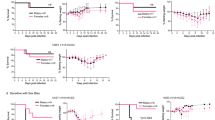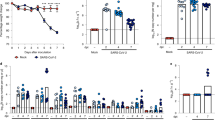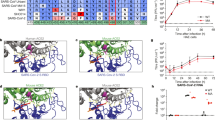Abstract
The Severe Acute Respiratory Syndrome Coronavirus-2 (SARS-CoV-2) remains a public health concern and a subject of active research effort. Development of pre-clinical animal models is critical to study viral-host interaction, tissue tropism, disease mechanisms, therapeutic approaches, and long-term sequelae of infection. Here, we report two mouse models for studying SARS-CoV-2: A knock-in mAce2F83Y,H353K mouse that expresses a mouse-human hybrid form of the angiotensin-converting enzyme 2 (ACE2) receptor under the endogenous mouse Ace2 promoter, and a Rosa26 conditional knock-in mouse carrying the human ACE2 allele (Rosa26hACE2). Although the mAce2F83Y,H353K mice were susceptible to intranasal inoculation with SARS-CoV-2, they did not show gross phenotypic abnormalities. Next, we generated a Rosa26hACE2;CMV-Cre mouse line that ubiquitously expresses the human ACE2 receptor. By day 3 post infection with SARS-CoV-2, Rosa26hACE2;CMV-Cre mice showed significant weight loss, a variable degree of alveolar wall thickening and reduced survival rates. Viral load measurements confirmed inoculation in lung and brain tissues of infected Rosa26hACE2;CMV-Cre mice. The phenotypic spectrum displayed by our different mouse models translates to the broad range of clinical symptoms seen in the human patients and can serve as a resource for the community to model and explore both treatment strategies and long-term consequences of SARS-CoV-2 infection.




Similar content being viewed by others
References
Akkiz H (2023) Unraveling the molecular and cellular pathogenesis of COVID-19-associated liver injury. Viruses 15(6):1287
Al-Aly Z, Xie Y, Bowe B (2021) High-dimensional characterization of post-acute sequelae of COVID-19. Nature 594:259–264
Bao L, Deng W, Huang B, Gao H, Liu J, Ren L, Wei Q, Yu P, Xu Y, Qi F, Qu Y, Li F, Lv Q, Wang W, Xue J, Gong S, Liu M, Wang G, Wang S, Song Z, Zhao L, Liu P, Zhao L, Ye F, Wang H, Zhou W, Zhu N, Zhen W, Yu H, Zhang X, Guo L, Chen L, Wang C, Wang Y, Wang X, Xiao Y, Sun Q, Liu H, Zhu F, Ma C, Yan L, Yang M, Han J, Xu W, Tan W, Peng X, Jin Q, Wu G, Qin C (2020) The pathogenicity of SARS-CoV-2 in hACE2 transgenic mice. Nature 583:830–833
Brielle ES, Schneidman-Duhovny D, Linial M (2020) The SARS-CoV-2 exerts a distinctive strategy for interacting with the ACE2 human receptor. Viruses 12(5):497
Carofino BL, Justice MJ (2015) Tissue-specific regulation of oncogene expression using cre-inducible ROSA26 knock-in transgenic mice. Curr Protoc Mouse Biol 5:187–204
Chen S, Lee B, Lee AY, Modzelewski AJ, He L (2016) Highly efficient mouse genome editing by CRISPR ribonucleoprotein electroporation of zygotes. J Biol Chem 291:14457–14467
Chu VT, Weber T, Graf R, Sommermann T, Petsch K, Sack U, Volchkov P, Rajewsky K, Kuhn R (2016) Efficient generation of Rosa26 knock-in mice using CRISPR/Cas9 in C57BL/6 zygotes. BMC Biotechnol 16:4
Hamming I, Timens W, Bulthuis ML, Lely AT, Navis G, van Goor H (2004) Tissue distribution of ACE2 protein, the functional receptor for SARS coronavirus. A first step in understanding SARS pathogenesis. J Pathol 203:631–637
Harvey WT, Carabelli AM, Jackson B, Gupta RK, Thomson EC, Harrison EM, Ludden C, Reeve R, Rambaut A, Peacock SJ, Robertson DL, Consortium C-GU (2021) SARS-CoV-2 variants, spike mutations and immune escape. Nat Rev Microbiol 19:409–424
Hohenstein P, Slight J, Ozdemir DD, Burn SF, Berry R, Hastie ND (2008) High-efficiency Rosa26 knock-in vector construction for Cre-regulated overexpression and RNAi. PathoGenetics 1:3
Huang C, Wang Y, Li X, Ren L, Zhao J, Hu Y, Zhang L, Fan G, Xu J, Gu X, Cheng Z, Yu T, Xia J, Wei Y, Wu W, Xie X, Yin W, Li H, Liu M, Xiao Y, Gao H, Guo L, Xie J, Wang G, Jiang R, Gao Z, Jin Q, Wang J, Cao B (2020) Clinical features of patients infected with 2019 novel coronavirus in Wuhan, China. Lancet 395:497–506
Jiang RD, Liu MQ, Chen Y, Shan C, Zhou YW, Shen XR, Li Q, Zhang L, Zhu Y, Si HR, Wang Q, Min J, Wang X, Zhang W, Li B, Zhang HJ, Baric RS, Zhou P, Yang XL, Shi ZL (2020) Pathogenesis of SARS-CoV-2 in transgenic mice expressing human angiotensin-converting enzyme 2. Cell 182:50–58
Li W, Zhang C, Sui J, Kuhn JH, Moore MJ, Luo S, Wong SK, Huang IC, Xu K, Vasilieva N, Murakami A, He Y, Marasco WA, Guan Y, Choe H, Farzan M (2005) Receptor and viral determinants of SARS-coronavirus adaptation to human ACE2. EMBO J 24:1634–1643
Liu Y, Liu J, Plante KS, Plante JA, Xie X, Zhang X, Ku Z, An Z, Scharton D, Schindewolf C, Widen SG, Menachery VD, Shi PY, Weaver SC (2022) The N501Y spike substitution enhances SARS-CoV-2 infection and transmission. Nature 602:294–299
Mistrulli R, Ferrera A, Muthukkattil ML, Volpe M, Barbato E, Battistoni A (2023) SARS-CoV-2 related myocarditis: what we know so far. J Clin Med 12(14):4700
Mittal A, Khattri A, Verma V (2022) Structural and antigenic variations in the spike protein of emerging SARS-CoV-2 variants. PLoS Pathog 18:e1010260
Oguz SH, Yildiz BO (2023) Endocrine disorders and COVID-19. Annu Rev Med 74:75–88
Pandharipande P, Williams Roberson S, Harrison FE, Wilson JE, Bastarache JA, Ely EW (2023) Mitigating neurological, cognitive, and psychiatric sequelae of COVID-19-related critical illness. Lancet Respir Med 11:726–738
Pattanaik A, Bhandarkar BS, Lodha L, Marate S (2023) SARS-CoV-2 and the nervous system: current perspectives. Arch Virol 168:171
Qiu Y, Zhao YB, Wang Q, Li JY, Zhou ZJ, Liao CH, Ge XY (2020) Predicting the angiotensin converting enzyme 2 (ACE2) utilizing capability as the receptor of SARS-CoV-2. Microbes Infect 22:221–225
Reed LJ, Muench H (1938) A simple method of estimating fifty percent endpoints. Am J Epidemiol 27:493–497
Sun SH, Chen Q, Gu HJ, Yang G, Wang YX, Huang XY, Liu SS, Zhang NN, Li XF, Xiong R, Guo Y, Deng YQ, Huang WJ, Liu Q, Liu QM, Shen YL, Zhou Y, Yang X, Zhao TY, Fan CF, Zhou YS, Qin CF, Wang YC (2020) A mouse model of SARS-CoV-2 infection and pathogenesis. Cell Host Microbe 28:124–133
Tao X, Garron T, Agrawal AS, Algaissi A, Peng BH, Wakamiya M, Chan TS, Lu L, Du L, Jiang S, Couch RB, Tseng CT (2016) Characterization and demonstration of the value of a lethal mouse model of middle east respiratory syndrome coronavirus infection and disease. J Virol 90:57–67
Tseng CT, Huang C, Newman P, Wang N, Narayanan K, Watts DM, Makino S, Packard MM, Zaki SR, Chan TS, Peters CJ (2007) Severe acute respiratory syndrome coronavirus infection of mice transgenic for the human Angiotensin-converting enzyme 2 virus receptor. J Virol 81:1162–1173
Wrapp D, Wang N, Corbett KS, Goldsmith JA, Hsieh CL, Abiona O, Graham BS, McLellan JS (2020) Cryo-EM structure of the 2019-nCoV spike in the prefusion conformation. Science 367:1260–1263
Yang B, Liu C, Ju X, Wu B, Wang Z, Dong F, Yu Y, Hou X, Fang M, Gao F, Guo X, Gui Y, Ding Q, Li W (2023) A tissue specific-infection mouse model of SARS-CoV-2. Cell Discov 9:43
Yap TF, Hsu JC, Liu Z, Rayavara K, Tat V, Tseng CK, Preston DJ (2022) Efficacy and self-similarity of SARS-CoV-2 thermal decontamination. J Hazard Mater 429:127709
Yinda CK, Port JR, Bushmaker T, Offei Owusu I, Purushotham JN, Avanzato VA, Fischer RJ, Schulz JE, Holbrook MG, Hebner MJ, Rosenke R, Thomas T, Marzi A, Best SM, de Wit E, Shaia C, van Doremalen N, Munster VJ (2021) K18-hACE2 mice develop respiratory disease resembling severe COVID-19. PLoS Pathog 17:e1009195
Zhou P, Yang XL, Wang XG, Hu B, Zhang L, Zhang W, Si HR, Zhu Y, Li B, Huang CL, Chen HD, Chen J, Luo Y, Guo H, Jiang RD, Liu MQ, Chen Y, Shen XR, Wang X, Zheng XS, Zhao K, Chen QJ, Deng F, Liu LL, Yan B, Zhan FX, Wang YY, Xiao GF, Shi ZL (2020) A pneumonia outbreak associated with a new coronavirus of probable bat origin. Nature 579:270–273
Zhou B, Thao TTN, Hoffmann D, Taddeo A, Ebert N, Labroussaa F, Pohlmann A, King J, Steiner S, Kelly JN, Portmann J, Halwe NJ, Ulrich L, Trueb BS, Fan X, Hoffmann B, Wang L, Thomann L, Lin X, Stalder H, Pozzi B, de Brot S, Jiang N, Cui D, Hossain J, Wilson MM, Keller MW, Stark TJ, Barnes JR, Dijkman R, Jores J, Benarafa C, Wentworth DE, Thiel V, Beer M (2021) SARS-CoV-2 spike D614G change enhances replication and transmission. Nature 592:122–127
Zhu N, Zhang D, Wang W, Li X, Yang B, Song J, Zhao X, Huang B, Shi W, Lu R, Niu P, Zhan F, Ma X, Wang D, Xu W, Wu G, Gao GF, Tan W, China Novel Coronavirus I, Research T (2020) A novel coronavirus from patients with pneumonia in China, 2019. N Engl J Med 382:727–733
Acknowledgements
The SARS-CoV-2 WA1/2020 used in this study was a kind gift from Dr. Natalie Thornburg at the Centers for Disease Control (CDC), Atlanta, GA, through the World Reference Center for Emerging Viruses and Arboviruses (WRCEVA). This project was supported by the Genetically Engineered Rodent Model (GERM) Core at BCM.
Funding
RM was supported by NIH/NIGMS T32GM07526. This project was supported by the Genetically Engineered Rodent Model (GERM) Core at BCM, which is funded in part by the National Institutes of Health Cancer Center Grant (P30 CA125123).
Author information
Authors and Affiliations
Contributions
Conceptualization: IS, JDH, CKT, BL and RM. Methodology & investigation: IS, MW, CL, JH, KR, YC, MJ, AD, VT, DGL, IL and RM. Project administration: YB and NH. Supervision: CKT, BL and RM. Writing—original draft: IS, CKT, BL and RM. Writing—review & editing: All authors reviewed and edited the manuscript.
Corresponding author
Ethics declarations
Competing interests
The authors have no competing interests to disclose.
Additional information
Publisher's Note
Springer Nature remains neutral with regard to jurisdictional claims in published maps and institutional affiliations.
Supplementary Information
Below is the link to the electronic supplementary material.
Rights and permissions
Springer Nature or its licensor (e.g. a society or other partner) holds exclusive rights to this article under a publishing agreement with the author(s) or other rightsholder(s); author self-archiving of the accepted manuscript version of this article is solely governed by the terms of such publishing agreement and applicable law.
About this article
Cite this article
Song, IW., Washington, M., Leynes, C. et al. Generation of a humanized mAce2 and a conditional hACE2 mouse models permissive to SARS-COV-2 infection. Mamm Genome (2024). https://doi.org/10.1007/s00335-024-10033-8
Received:
Accepted:
Published:
DOI: https://doi.org/10.1007/s00335-024-10033-8




